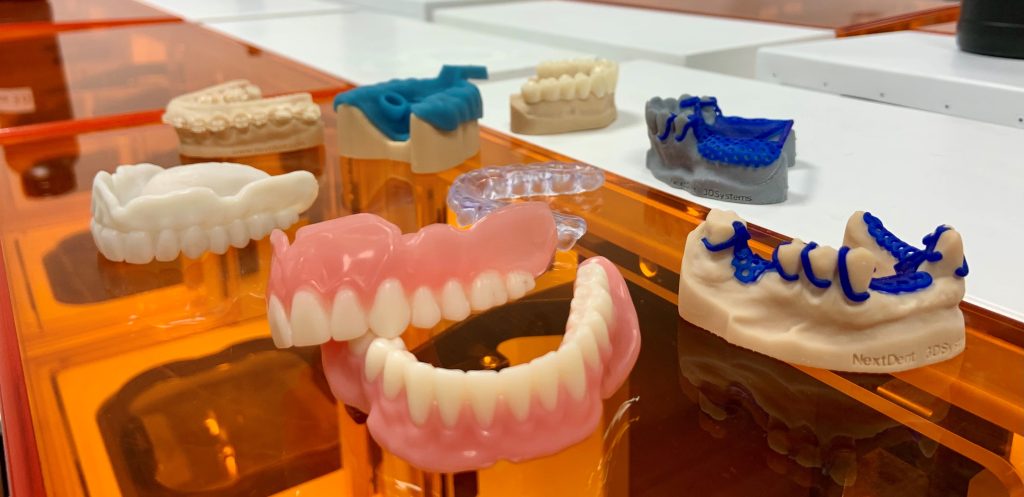Register now for the Additive Manufacturing Advantage event for insights on AM developments in aerospace, space, and defense sectors from industry leaders!
3D printer manufacturer 3D Systems saw its stock price jump 19% to $4.11 in after-hours trading on Tuesday following its biggest contract announcement to produce clear dental aligners valued at nearly $250 million over five years.
This news comes despite the stock closing down 1.4% earlier in the day and remaining down about 46% for the year. 3D Systems plans to capitalize on this momentum by commercially launching direct printing technology for clear aligners by late 2025. Additionally, the company is expanding its dental product portfolio to include solutions for alignment, protection, repair, and tooth replacement (both partial and full).
“Leveraging our fully integrated materials, hardware, and software development teams, we are working with market leaders in each dental product category, to bring these new applications to market as rapidly as possible. Our belief is that this approach offers maximum benefit to dental patients as they gain access to better performing, more cost-effective solutions to meet their personal lifetime needs,” said, Dr. Jeffrey Graves, President & CEO of 3D Systems.

3D Systems’ dental prowess
By leveraging NextDent technologies, 3D Systems plans to broaden its presence in emerging oral applications such as night guards. This market is expanding in response to the widespread issue of preventing teeth damage caused by night grinding, which affects millions worldwide and is also utilized in sleep apnea treatment. Anticipating a pivotal role in its dental technology lineup, 3D Systems foresees night guards becoming a substantial component in the years ahead.
In February, 3D Systems introduced a solution for multi-material, jetted, one-piece dentures, highlighting progress in additive manufacturing for dental applications. This innovative denture solution promises durable, aesthetically pleasing prosthetics crafted from specialized materials for teeth and gums. Leading dental laboratories, such as Glidewell, have expressed keen interest, underscoring its industry appeal. Anticipating FDA clearance in the latter half of 2024, 3D Systems plans to swiftly proceed with commercialization efforts.
In an interview, Chuck Stapleton, VP and GM for Dental at 3D Systems discussed his take on 3D printing in dental production. He highlighted collaborations with both large and small dental labs, including Align Technology, emphasizing the ability to overcome pandemic challenges and maintain a positive market outlook.
Stapleton detailed 3D Systems’ extensive portfolio, which includes orthodontics, prosthetics, and more, noting the integration with legacy workflows and metal printing for crowns. He projected accelerated adoption of 3D printing, driven by an aging workforce with an average age of 56 and the growing need for precise, digital solutions. Additionally, Stapleton predicted significant growth in denture and crown applications, with the digital dental segment expected to reach $12.2 billion by 2028, growing at a CAGR of 10.9%.
A growing dental 3D printing market
According to Vantage Market Research, cited by 3D Systems, the global market for dental 3D printing is projected to reach a value of $14.6 billion by 2032. Several companies other than 3D Systems are well on their way to contributing to the statistics.
At the International Dental Show, Carbon introduced a new production option for dental aligners, last year. This sustainable solution promises significant savings, boasting up to a 65% increase in throughput and reduced material usage per print, resulting in lower costs per part.
The Carbon Gen 2 aligner model integrates proprietary software and high-performance resin with existing systems. This solution includes the Carbon L1 3D printer, API-based software, and solventless spin-cleaning for automated hollowing, nesting, and batching. Tests demonstrate that automated hollowing saves 40% of resin per item, while using UMA 20 resin achieves a 65% increase in component throughput.
Elsewhere, Boston Micro Fabrication introduced its novel UltraThineer, touted as “the world’s thinnest cosmetic dental veneer.” Produced using projection micro stereolithography (PµSL), these veneers are significantly thinner than traditional options, reducing preparatory steps, and preserving enamel integrity. Pending FDA evaluation, UltraThineer veneers, with a thickness of only 100 µm, are expected to launch in the U.S. market in spring 2024.
What 3D printing trends do the industry leaders anticipate this year?
What does the Future of 3D printing hold for the next 10 years?
To stay up to date with the latest 3D printing news, don’t forget to subscribe to the 3D Printing Industry newsletter or follow us on Twitter, or like our page on Facebook.
While you’re here, why not subscribe to our Youtube channel? Featuring discussion, debriefs, video shorts, and webinar replays.
Featured image shows NextDent 5100 addresses multiple applications combined with the wide range of validated NextDent materials. Photo via 3D Systems.



